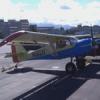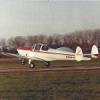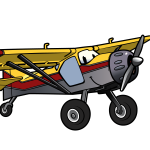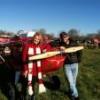Activity Stream
Posts Activity Stream
-
-
Leni,
If you have a drawing, I have a CNC Mill and a teenager with time on his hands.
1 person likes this -
Hahaha
 Jeff, I'll have to show you some of the few that I know. I do want to get down to check out the Kustatan that Leni mentioned. I guess it can be kind of busy but productive. We need to get Leni to show us the Lake Creek spots.
Jeff, I'll have to show you some of the few that I know. I do want to get down to check out the Kustatan that Leni mentioned. I guess it can be kind of busy but productive. We need to get Leni to show us the Lake Creek spots. -
I like the way the way they work with a little flush lever that pulls the inner and outer plates of the cap together to squeeze the O-ring between that seals it .
-
One last thought on all the good things that Randy told you:
If you see Lenticular clouds (normally by mountains) stay well away from them. You can encounter extreme turbulence, like the Evergreen 747 taking off toward the Chugach range and turning north over my house in East Anchorage - the turbulence took an engine off of it, and it dropped at Boniface and Northern Lights between the mall and apartments a block away from me.
EDMO
-
-
Jeff, First I try to avoid what I can see. Don't fly under thunder head clouds or even close to them. The varga rain you can see will have down drafts with it. Any change in layers will be rough; you will notice this as you get up close to a cloud layer. If you can't avoid the thunderstorm, get on the ground and wait it out.
Like Leni says, when flying in the mountains, picture the direction of the wind and what it would be doing if it was water flowing over the ridges or canyons; it's going to cause an updraft on the front side of the ridge or mountain and a downdraft on the backside and also turbulance over and around the mountains and ridges. If you have wind coming out of the north and you fly on the south side of Sleeping Lady, you are going to get a rude pounding. Better give yourself some distance from it (like about to the edge of the inlet) so you don't get slammed to the ground. Flying into canyons, I always try to get close and feel how rough it is getting and be prepared to turn around if it gets too bad. If you see dust kicking up off the river sand bars you can expect the wind to be blowing about 30+ mph. This may be flyable, even smooth if you are in the middle of a relatively flat or wide valley floor but be careful when you get toward the edges or transition into an intersecting valley or canyon. 30 mph makes for some nasty turbulence in in the mountains in our planes and anything above that is dangerous as far as my personal limits go.
Thermals are interesting and can give you some real lumps in the throat and stomach. If you fly over the hay flats or the wetlands and lakes of the Kenai area when it heats up on a hot afternoon you will be going up and down at 1000 fpm pretty regularly, but on the same day if you go out to the edge of the Cook Inlet and fly the beach line it will be nice and smooth along the water. If you fly down the the Soldotna pancake breakfast with us on 8 June you will get to experience this (if the day is a nice hot one).
For the invisible microbursts, about all I can say is they are going to be a lot more likely with thunderstorms around building or breaking down. Like Ed said, if you happen to see dust on the ground, wind in the trees, grass, or water that looks like it is only in one spot, get the heck out of there. You can't out climb it, just try to keep your wings and attitude as level as possible and try to fly out the side of it like Leni said.
Read the book on Mountain Flying by Sparky Imeson (I think that is his name). Also, the book on flying in Alaska by Potts (can't remember the exact name). Another great book by a friend of mine who lives on Wolf Lake is "Survival Flying" by C. Jay Baldwin. These all give good advice on bush type flying from those who have learned things the hard way and provide good advice so hopefully we can avoid some of the negative lessons learned. I always consider myself to be an amature, and learn from everyone else I can.
-
That's not the same Heavy that I posted. Interesting - and no multi-engine license needed to fly it.
EDMO
-
-
So-- If I don't fish and don't really hunt, is there no real good reason for me to ever come to Alaska?
That sucks.
-
-
There are some good glider pilot's books available that will help you study the terrain and weather conditions - you just asked about the worst surprise for a pilot - these have caused large jet passenger planes to crash. Hopefully, none of us will fly into or try to outclimb a thunderstorm, but you cant see the wind all of the time.
I watched an NTSB film taken from a helicopter that was flying close to an INVISABLE TORNADOE - You couldn't see any sign of it except the trees and grass below being blown around in a circle.
EDMO
-
Leni, there was a guy near Nikiski, that made a complete Hi-Vo chain redrive for David Goode - David had it on a boat, before he got his Airdale. If you could locate him, or if I can find his name and address, I'm sure you would have no problem getting him to make an adapter for you, if he is still in business.
He even shared his drawings with me at no charge.
I will look for his info.
EDMO
-
This will be argued, but the best bang for the buck is still a 912.
It's supported, economical, reliable, powerful, light, and most of all, light.
Personally, I've never seen a successful 670 install that was worth the headaches.
1 person likes this -
There are several areas you can land along the Kustatan river that offer GREAT fishing for silvers. Get good on the gravel bars and depending on water levels, there are a few bars on Lake Creek that you can land. Kings should be in there right now, but make sure the area is open! I think its fly fishing only but I could be wrong, check the regs! I have a blast fishing Lake Creek with a 5 weight catching everything from Grayling to kings and all species in between.
Most of my fly in fishing spots are for floats... Get those bad boys mounted up, just watch the fiberglass floats on the river rocks !! I would be more prone to keeping those in the lakes..
Randy can tell you better some of the areas up in the Valley, most of my spots are West of there, but the illiamna area offers mind blowing fishing, it just takes our slow planes a little while to get there!

-
Leni, Randy, Anybody.
No that I added the cargo pod to my plane, it is anxious to have something in it. Where are the best fly in salmon fishing areas?
Thanks
-
I am still working on a fuel injected 2 stroke, but the machinist I had working on the adapter plate figured out what I was doing and he dropped the project like a hot rock.. I am looking for another machinist to make the adapter plate for my "airboat" project now.
I am not sure if you could make a shorter mount for the 912 to minimize the nose weight. You could take the lead out of the tail and put the battery back there too so your not adding dead weight to the plane.
I was told the 670 was spose to be better on the fuel burn than the 582 because it was just kind of "loafing" along and not really working hard.
I really hope to get my project working soon, but it seems to take alot longer to develope than originally thought.

-
that is the killer on micro bursts Jeff.. One minute your flying along in clear blue skys, not a breath of wind, the world is a perfect place to be, then wham.. your getting slammed down against the shoulder harness and the VSI is pegged out going the wrong direction.. We are not "spose" to have them up here, but I have hit them more than once! At that point your just praying you can get to the edge of it before you hit the ground. Think water fall effect. It will go straight down in the center to the ground, but on the edges it will be shooting back up like the mist clouds on a good water fall. The ones I hit I could not outclimb them, full power, nose pointed at the sky and still dropping at 2000+ FPM. drop the nose and just try to find the edge is all I can say..
The down drafts can be a bit easier to predict if your flying in the mountains. If your in a pass and the wind is coming across the mountain tops say left to right, your going to want to stay towards the right side of the pass as you will have a down draft on the left side with the winds coming over the top and dropping over the ridge, across the valley floor and probably an updaft on the far side.
There can be quite a bit of thermal activity over the hay fields etc in the plamer / wasilla area. We use them ALOT to fly the model gliders etc. Early in the morning, and later in the evening it is normally calm, but during the heat of the day, there can be some serious thermal activity in the area. Nothing to worry about really, but it can get a bit bumpy with our light planes.

-
I need more engine than the 582 offers for my model 2 now that I am dragging 29" Airstreaks around.
I have already added 9 pounds of lead to the tail so 912 or Subaru will probably not be options.
I tried the 80 HP Jabiru with mixed results but have heard the 85 HP Jabiru is significantly better.
I have not heard much about the Rotax 670 lately.
Have the 670's been working out?
I heard they are very thirsty.
Seems like Leni was working on a 2 stroke option.
Thanks Herman
-
-
My J3 Buddy called me and said to find this on the internet.
Crude construction, and looks heavy - but sooo interesting and inventive construction - like the electric box for the stick gimbal. The single spar looks like it will not prevent wing warp, no matter how many stringers he adds to it.
Betting it weights too much to fly, but worth looking at.
EDMO
-
Leni, Randy,
Is there anyway to forsee a down draft or micro burst before flying into it. When are weather conditions most likely to produce such conditions? Your experience with the semi is something I never want to encounter.
-
If the engine is running normal at all levels it sounds to me like some characteristics with the airflow over the wing. Like Leni indicated something with the air. I found out the other day that even an AVID flying slightly above and in front of my AVID can be catastrophic to lift.
-
Regarding landing these little Avids and KF's.
I learned to fly in T- craft and Champs 36 years ago and thought I was a real tail dragger pilot.
18 years ago I flew my Model 2 Kitfox for the first time, having flown a Champ the day before and almost lost it.
These airplanes are to be respected since they react quickly to control inputs.
I have never flown a Pitts, but I am sure they would be another step above in control management.
I now land much differently than I did in the past when trying to land as short as possible.
I always wondered why on the extreme backcountry videos why the pilots were doing wheel landings which normally have higher approach speeds.
I have learned that what looks like a wheel landing is really a modified full stall 3 point landing approach, that as soon as the mains touch you get on the brakes and elevator as needed and the tail wheel never touch's till you are stopped.
Using this technique I have found that for the first time in all these years and hundreds of hours that I can land my Kitfox shorter than I can take off.
It does not help that everything I have done to land in short rough strips has added weight but huge amounts of confidence.
I still use the original Model 2 bungee gear with no issues so far and have considered the after market gears for better Angle of Attack.
This thread has cautioned me to reconsider because of the mentioned failures.
I always thought the Grove gear was too heavy to consider so I would like some input from this forum.
Ed; would you please call me regarding your Grove.
Thanks Herman Pahls Oregon cell 541-404-6464
-







Flaperon mount bracket angles
in Technical tasks
jackak
Posted
Thanks Leni. The flaperons move smoothly in both directions, when you turn them to either limit and then release them, they move freely to the position that the weight wants to go. Weight pointing down in this case because the wings are in a rack, trailing edges up.
Thanks again,
Jack